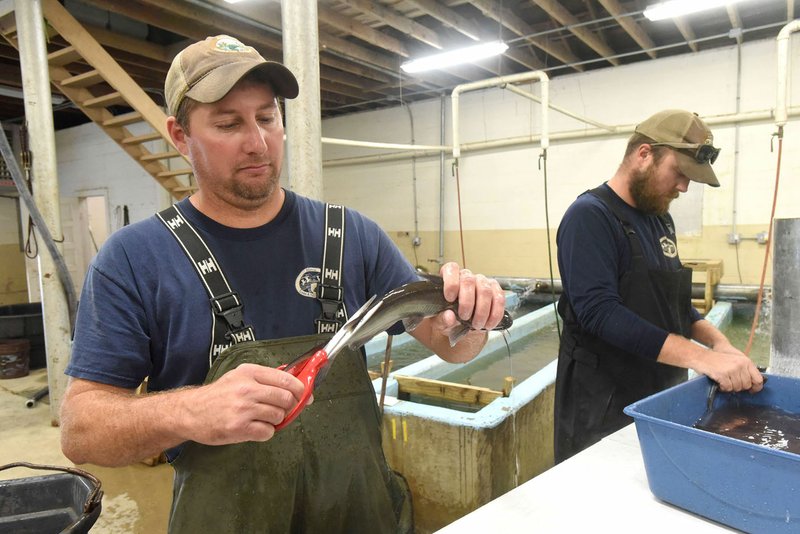There's more than one way to catch a catfish. Trotlines, limb lines, jug fishing, rod and reel, even catching them by hand, all put old whiskers in the boat or on the bank.
Channel catfish are a favorite target and the Arkansas Game and Fish Commission makes sure there are plenty for anglers to catch. Catfish reproduce naturally in all the region's lakes and rivers. Now and then Game and Fish stocks catfish to increase their numbers.
Catch a catfish
Channel, flathead and blue catfish all swim in Beaver Lake. Good channel catfish baits are nightcrawlers, liver and stink bait. Use goldfish or small sunfish for flathead catfish.
The daily limit is 10 catfish.
Source: Arkansas Game and Fish Commission
That's true at Beaver Lake, where fisheries biologists keep tabs on their numbers in a unique way. By marking channel catfish before they're stocked in the reservoir, biologists can find out what percentage of the population occurs naturally and what percentage is stocked.
It starts with a flurry of activity at the Charlie Craig State Fish Hatchery at Centerton.
More than a dozen biologists, technicians and managers with Game and Fish use scissors to clip a small piece of fin from the back of 60,000 channel catfish destined for stocking at Beaver. After the fin clip, each young catfish gets a freeze brand about an inch long on its side.
A tank of liquid nitrogen makes a piece of metal on the tanks' side ice-cold to apply the freeze brand.
Thousands of catfish swirl in long concrete tanks inside a hatchery building. Catfish are scooped up in long-handled nets and dumped into heavy-duty plastic tubs for marking.
Those 60,000 catfish are now swimming in Beaver Lake.
"Next year, we'll use baited hoop nets to catch catfish at the lake," said Jon Stein, area fisheries biologist with Game and Fish. "We'll be able to tell what percentage of those fish were stocked and what percentage were spawned naturally."
Biologists will see the fin clip and brand of the stocked catfish. Naturally occurring ones will have fins intact.
"What we've found is that about 20 percent of the channel catfish in Beaver Lake were stocked," Stein said. Eighty percent were spawned naturally.
The percentages give Game and Fish an idea of how many channel catfish to stock to maintain good fishing for anglers. If the natural reproduction rate falls, it may mean more catfish should be stocked.
Anglers, too, can tell if a channel 'cat is a stocked fish, Stein said. The freeze brand on the side of a stocked catfish turns black over time and fishermen should also notice the clip on the adipose fin, just behind the dorsal fin.
The study is specific to channel catfish, not flatheads or blue catfish, Stein said. Beaver has a thriving population of flathead catfish, he added.
Joe Adams, hatchery manager, said the catfish that were marked and stocked started as eggs at a Game and Fish hatchery at Lonoke. They grew to fingerling size, then were trucked to Centerton.
Clipping a fin doesn't impair the swimming ability of the fish, Adams assured.
It's the second year for the catfish study, Adams said. Plans are to do it for at least five years.
There's no need to study channel catfish at the region's small lakes, Stein said. Biologists know that catfish reproduction in those lakes is poor. Catfish are cavity spawners, he said, and there aren't enough hollow logs, ledge cover or holes for good spawns.
If Game and Fish didn't stock catfish in the small lakes, those waterways wouldn't have catfish, Stein said.
Channel catfish eat all kinds of bait. Nightcrawlers, liver, worms, hot dogs and stink bait all holler "come and get it" to a channel catfish.
Flip Putthoff can be reached at [email protected]
Sports on 10/02/2018

